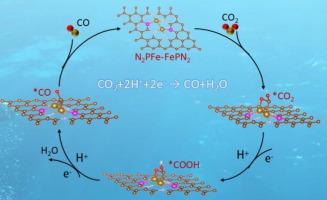用于促进二氧化碳电还原的 P 调节型 FeN2 双核位点
IF 13.1
1区 化学
Q1 Energy
引用次数: 0
摘要
通过电化学过程回收利用二氧化碳为缓解温室效应提供了一种前景广阔的解决方案;然而,在电催化二氧化碳还原(ECR)过程中,二氧化碳的活化和*CO的解吸经常会遇到高能量障碍和竞争性氢进化反应(HERs),这些都是亟待解决的问题。本研究成功合成了一种具有均相 P 调谐 FeN2 双核位点(N2PFe-FePN2)的催化剂(P100-Fe-N/C),在电催化 CO 还原中表现出令人满意的性能。P100-Fe-N/C 的峰值 FECO 为 98.01%,在 -0.7 VRHE 条件下的归一化 TOF 为 664.7 h-1,超过了不含 P 的 Fe 双核催化剂和单原子催化剂的性能。在 MEA 单元中,FECO 仍可超过 90%。密度泛函理论分析表明,P 的加入引起的不对称配位构型有助于降低系统能量。P 的调制使催化剂的 d 波段中心更接近费米级,从而促进了催化剂与 CO2 的相互作用,使更多的电子在 Fe 双核位点注入 CO2 分子,抑制了 HER。P调谐的 FeN2 双核位点有效降低了*CO 解吸障碍。本文章由计算机程序翻译,如有差异,请以英文原文为准。

P-tuned FeN2 binuclear sites for boosted CO2 electro-reduction
The recycling of CO2 through electrochemical processes offers a promising solution for alleviating the greenhouse effect; however, the activation of CO2 and desorption of *CO in electrocatalytic CO2 reduction (ECR) frequently encounter high energy barriers and competitive hydrogen evolution reactions (HERs), which are urgent problems that need to be addressed. In this study, a catalyst (P100–Fe–N/C) with homogeneous P–tuned FeN2 binuclear sites (N2PFe-FePN2) was successfully synthesised, demonstrating satisfactory performance in the ECR to CO. P100–Fe–N/C attains a peak FECO of 98.01% and a normalized TOF of 664.7 h−1 at −0.7 VRHE, surpassing the performance of the Fe binuclear catalyst without P and single-atoms catalysts. In the MEA cell, a FECO exceeding 90% can still be achieved. Density functional theory analysis indicates that the asymmetric coordination configuration induced by the incorporation of P facilitates a reduction in the system’s energy. The modulation of P results in the d-band centre of the catalyst being positioned closer to the Fermi level, which facilitates the interaction of the catalyst with CO2, allowing more electrons to be injected into the CO2 molecule at the Fe binuclear sites and inhibiting the HER. The P–tuned FeN2 binuclear sites effectively lower the *CO desorption barrier.
求助全文
通过发布文献求助,成功后即可免费获取论文全文。
去求助
来源期刊

Journal of Energy Chemistry
CHEMISTRY, APPLIED-CHEMISTRY, PHYSICAL
CiteScore
19.10
自引率
8.40%
发文量
3631
审稿时长
15 days
期刊介绍:
The Journal of Energy Chemistry, the official publication of Science Press and the Dalian Institute of Chemical Physics, Chinese Academy of Sciences, serves as a platform for reporting creative research and innovative applications in energy chemistry. It mainly reports on creative researches and innovative applications of chemical conversions of fossil energy, carbon dioxide, electrochemical energy and hydrogen energy, as well as the conversions of biomass and solar energy related with chemical issues to promote academic exchanges in the field of energy chemistry and to accelerate the exploration, research and development of energy science and technologies.
This journal focuses on original research papers covering various topics within energy chemistry worldwide, including:
Optimized utilization of fossil energy
Hydrogen energy
Conversion and storage of electrochemical energy
Capture, storage, and chemical conversion of carbon dioxide
Materials and nanotechnologies for energy conversion and storage
Chemistry in biomass conversion
Chemistry in the utilization of solar energy
 求助内容:
求助内容: 应助结果提醒方式:
应助结果提醒方式:


